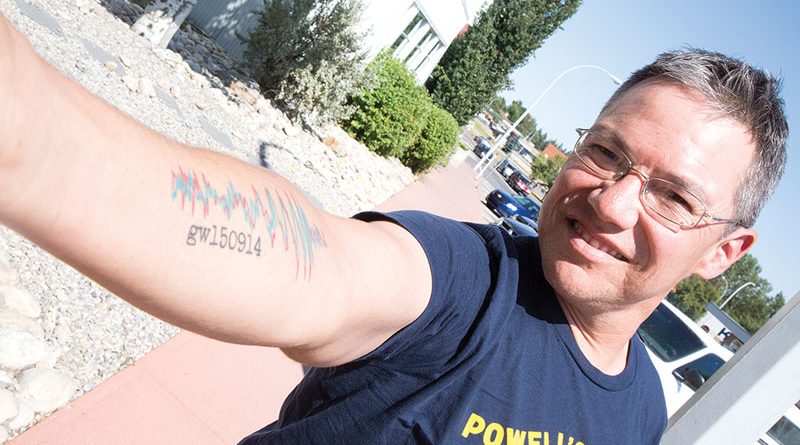Siksika’s own spreads knowledge of ground-breaking cosmic discovery
By Miriam Ostermann, Associate Editor


Miriam Ostermann Photo
The clock had just turned 2:15 a.m. Pacific time when the gravitational wave detector (interferometer) at the Laser Interferometer Gravitational-Wave Observatory (LIGO) in Hanford, Wash. began to shake, mimicking its counterpart 1,600 km away in Livingston, La.
At first, they moved slowly then became faster and faster before everything went quiet again. That event, on Sept. 14, 2015, lasted less than half a second. And while the world failed to take notice of the phenomenon at hand, nearly a thousand scientists, technicians, and engineers around the world – including lead operator with Siksika roots Corey Gray – jumped to action, setting out to prove the incident’s authenticity over the months to follow.
What the detectors exposed, coincidentally on the 100th anniversary of Albert Einstein’s theory of relativity, were gravitational waves passing through the Earth – the first detection in history and the revelation of a revolutionary new window into the cosmos.
By using Einstein’s equations from 1915, scientists were able to determine that those waves were the result of two black holes swirling around each other, reaching the speed of light before merging into one another for the creation of a greater black hole. The event, which occurred 1.3 billion light-years ago, caused the surrounding space to curve, sending out waves much like the ripple effect of a rock thrown into water. As the waves travelled through the universe at a distance of over one billion light-years away, they finally reached the Earth, causing the detectors to jiggle that morning two years ago.
Since then, the detectors have collected data on two more incidents, gained global recognition, and providing its inventor, 84-year-old Rainer Weiss, with the chance at a Nobel Prize in Physics this year.
“It’s hard to see the big picture when you’re building the machine and running it for the most part for a decade-and-a-half, it’s just a job… that night the morning after those emails were sent out it just totally slaps you in the face,” said Gray, lead operator at LIGO Hanford Observatory.
“You never even thought you’d be connected to Albert Einstein and now we all are. I was hesitant. I thought this can’t be real, we just barely turned it on and then we made this first detection and it was just this mind-blowing thing.”
Weiss’s brainchild, the interferometric gravitational wave detector that he dreamed up in 1972, consists of two arms spanning four kilometres in length suspended in a vacuum. Scientists analyze the data, ruling out any readings of over one-tenth of a second – gravitation waves move at the speed of light, therefore information gathered of disruptions slower than that are disregarded.
The information is then plugged into Einstein’s formula and fed into super-computers. From there, the source, the players, where it occurred, and the distance can be determined. The twin detectors also picked up a signal in January following the first event, and again this June. All three incidents of gravitational waves seem to be the result of black holes.
However, scientists remain optimistic of gathering data from other large objects, such as stars or comets. While the information provides further understanding into the study of black matter, experts say it opens up new areas of study in physics and astrophysics for future scientists.
“This really launches an entire new field of astronomy, one of gravitational-wave astronomy, not your ordinary electromagnetic astronomy, so it’s a brand new field that has just begun,” said physicist Michael Landry, head of LIGO Hanford Observatory.
“The interest here, is that you have a completely new and revelatory way of interacting with the universe. To date, all the astronomy is done with electromagnetic waves – light and radio waves and gamma rays – and that’s kind of like looking at the universe. But now you have a way of listening to the universe through gravitational waves. It’s kind of like applying a brand new sense to the universe.”
Corey Gray, who has a Bachelor of Science in Physics and Applied Mathematics, is one of only a few aboriginal employees working on the project. Accompanying the success of the discoveries, Gray returned to Siksika Nation last week to raise awareness about outreach work for science by hosting a Men’s Grass Dance Special together with his cousin Trudy Yellowfly.
Shedding light on the project and science in general is of great importance to Gray, who had his mother translate the press release of the discovery of gravitational waves into the Blackfoot language.
“Because it’s a huge discovery in science and I was involved, I got to do other things with outreach,” said Gray, whose parents grew up on Siksika Nation. “There are not that many native scientists. We could always use more native scientists, especially female scientists. People don’t think science is cool sometimes, especially when you’re young.
“When we made the announcement, we didn’t know how the world would react and it was just crazy to see all the interest.”
The LIGO gravitational wave detectors, together with the Virgo interferometer in Italy, are currently the only machines collecting data in the world. Detectors in India and Japan are expected to be functional within the next decade.
Gray headed back to Washington state over the weekend, to get back to the lab and collect more data before the detector is shut down for several months for routine upgrades and repairs.
